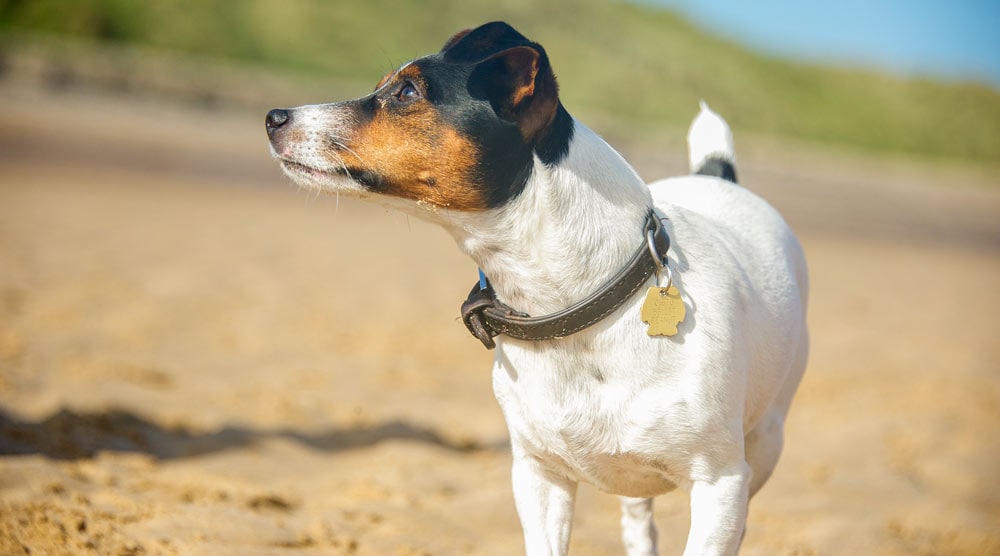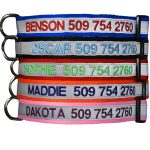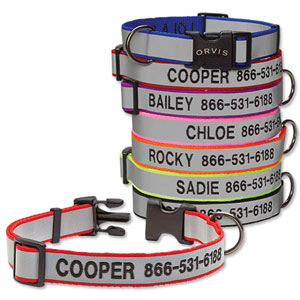A collar is essential for keeping your dog safe – but which is the best? And which should be avoided? In this article, Richard Cross lists his five best dog collars to help you get a comfortable, durable and safe collar for your pet.

Contents
As a dog lover, these statistics are shocking. I can’t imagine anything more heartbreaking than losing a beloved pet. Fortunately, I’ve never lost one of my dogs yet – but I’m constantly aware that it could happen.
For this reason, it’s vital for all dogs to have a durable collar showing your contact information. If your dog ever gets lost, the collar could make it much easier for you to be re-united. Collars can still be broken or removed, which is why micro-chipping is also important, but in many cases they are the difference between a dog that’s found quickly or not.
In this article, I’ve listed five of the best dog collars on the market. I considered features such as a safety, durable construction and adjustable design. So if you’re not sure which collar to get, these are a great place to start.
Our #1 Pick: GoTags Personalized Collar
Stitched contact info and great value
After hours of research on hundreds of products, I think the GoTags Personalized Dog Collar is the best dog collar. The stitched name and phone number make it easy for people to contact you if your dog is lost, while the reflective design increases visibility. It’s also comfortable for your dog.
What Makes a Great Collar?
Dog collars aren’t complicated – they are essentially a strip of fabric with a buckle. This doesn’t mean all collars are equal though, so you need to be careful when choosing. Here are some of the most important considerations when looking for a collar:
- Easily readable contact information. The main purpose of a collar is to identify your dog. For this reason, there should be a light-colored section to write your contact information – or at least an attachment point for a personalized tag. If the fabric can be embroidered with your address, go for this option as it’s less likely to be rubbed off.
- Durable material. The collar should be durable and able to withstand your dog’s daily activities. Some of the most common materials include leather, nylon, polyester and PVC. In general, I recommend synthetic materials such as nylon or polyester, as they are tough and won’t crack (like leather).
- Reflective. A reflective collar can make your dog more visible at night, which is especially important near roads. You may also want to consider an LED dog collar for extra brightness.
- Adjustable design. Most collars can be adjusted, but the best options allow you to properly secure the collar without excess material. You don’t want to create an unintentional loop of fabric after adjusting the collar, as this can get caught on crate bars, twigs or even other pets.
- Size. The American Kennel Association recommends you can fit two fingers comfortably underneath the collar. When your puppy is still growing, make sure you check the size of the collar regularly.
- Style. Last and most-definitely-least is the style of the collar. While it’s fun to give your dog stylish accessories, the appearance of the collar is secondary to comfort, safety and price. Even so, once you find a great collar there’s nothing wrong with choosing a design that matches your canine’s coat and fashion sense! Most collars come in a range of colors and patterns, or you can even look on places such as Etsy for more interesting designs (make sure it’s a high-quality collar when buying a custom design though).
It’s important to remember that a flat collar shouldn’t be used for walks – especially if your dog pulls. Collars don’t distribute force across a wide area, which means they can damage the dog’s spine and neck – especially if your dog is a consistent puller, jerks in a different direction, or runs to the end of a retractable dog leash. Harnesses are much safer and more comfortable on longer walks.
Tip: Are you looking for a collar for a Siberian husky or malamute? Check out our page about husky collars.

Should Your Dog Wear a Collar All The Time?
Collars are essential when your dog is outside, but some experts recommend removing them when the dog is supervised indoors. This is because collars can be a potential choke hazard. If you don’t want to remove the collar, you may want to consider a breakaway collar for extra safety.
5 Best Dog Collars in 2024
Now you know what to look for, here are five of the top-rated dog collars on the market. I’ve included several types of collar to suit various breeds and purposes, but each is durable and provides great value for money.
Note: This page is for basic flat collars with a standard design. I haven’t included training collars (many of these I don’t agree with), harnesses or martingale collars.
One of my top recommendations for a dog collar is the excellent GoTags Reflective Collar. It’s a simple collar that’s comfortable to wear, has stitched contact information and is made from highly reflective material. It’s also relatively cheap – so it provides great value for money.
The GoTags is made with strong nylon and a stainless steel D-Ring. Its buckle can be released with a single hand, which increases safety, while the edges are tapered to provide a more comfortable fit. A bonus is that it’s available in five colors, so you can match it to your dog’s style!
One of the great things about the GoTags (at least this version) is that it’s made with a reflective surface. This allows for greater visibility at night, which is helpful when walking and potentially life saving when near roads.
As the name suggests, the GoTags can be personalized. Your dog’s name and number are stitched into the collar, which means your contact details are always visible. The stitching means there are more seams for dirt to become stuck in, however, so you’ll need to spend extra time cleaning it to ensure it’s visible.
A downside to the GoTags is that it’s only available in three sizes. The smallest size only goes down to 11″ too, so it’s not suitable for the smallest breeds. Like most reflective collars, it also lacks the “classy” appearance of leather alternatives.
Even so, if your dog can wear the GoTags then it’s a fantastic collar that’s available for a great price. The durable design also means it’s likely to last a long time.
The GoTags Personalized Collar is a reflective option that’s available in three sizes and five colors. It’s adjustable, comfortable, reflective and has the name and phone number stitched into the collar, so it ticks all my boxes for a great collar. It’s also available for a very reasonable price.
- Material: Nylon
- Reflective: Yes
- Personalized: Yes
- Sizes Available: Small, Medium, Large
- Price Range: $$
- Highly reflective
- Stitched name and phone number
- Comfortable for your dog to wear
- Only three sizes available
- Tacky design
A more expensive option than the GoTags is the Orvis Reflective collar. It’s also a reflective and personalized collar, but is available in a wider range of sizes and colors.
Like most modern dog collars, the Orvis is made from strong Nylon. There are reflective borders to increase visibility, along with welded seams for improved strength. The D-Ring and side buckle are also “heavy duty” and designed to last a long time.
The Orvis has embroidered letters and numbers. A relatively large font is used, so people can read the pet’s name at a distance of 30 steps. This is useful if your dog is lost and whoever finds it needs to call him/her.
There are four sizes available. The smallest is suitable for dogs with neck sizes of 9″ or more. The largest goes up to dogs with a maximum of 26″. As you would expect from a top-quality collar, the Orvis is also adjustable, which is useful if your dog is still growing or has long hair.
One of the advantages of the Orvis is that it’s highly durable. The welded seams are tough and difficult to break, as they don’t use glue or threaded attachments. Despite the strong design, the collar still feels soft. It’s also not too stiff.
Another advantage is that Orvis offers a lifetime guarantee on their products. This provides extra peace of mind – especially if your pet has a habit of destroying his collars!
There aren’t many drawbacks to the Orvis as it’s an excellent collar. The biggest is the price, as it’s one of the most expensive basic collars on the market. I think the reflective strips could also be brighter – although they are still easily visible in low-light conditions.
Despite these minor issues, the Orvis is probably the best dog collar on the market. It’s strong, reflective, personalized and comfortable to wear, so if you don’t mind paying extra it’s the one to get. The “Small” size is also one of the best small dog collars, as it’s suitable for dogs with a 9″ neck.
The Orvis Reflective dog collar is a high-quality product that your pet will find comfortable to wear. It also has embroidered contact details that can be read at 30 paces. While it’s a bit more expensive than the GoTags, it’s more durable and has a lifetime guarantee.
- Material: Nylon
- Reflective: Yes
- Personalized: Yes
- Sizes Available: Small, Medium, Large, X-Large
- Price Range: $$$
- Lifetime guarantee
- Highly durable with welded seams
- Personalized and reflective
- Expensive
- Tacky design
If you’re not a fan of nylon collars, the Perri’s Padded Leather collar has a stylish and traditional design that looks great on most dogs. It’s also made from soft lambskin padding, so your dog won’t find it uncomfortable to wear.
The Perri’s is made with a leather exterior, soft padding and classic styling. It’s also Amish-made in America, unlike many cheaper collars which tend to be manufactured in China. In terms of craftsmanship, there aren’t many collars that can match this one.
Probably the best thing about the Perri’s is its appearance. There’s no denying this is a stylish collar, with a traditional appeal that can’t be matched by nylon options. As I mentioned earlier, style isn’t everything, but many people love the appearance of a leather collar.
It’s not just stylish though – the collar is also highly durable. It can withstand swimming, the occasional chew and running through tough environments. The padding also makes it comfortable for your dog – as long as you get the right size.
With five sizes and an X-Small that fits dogs with necks as little as 8″, the Perri’s is suitable for almost any dog (make sure you use the size chart to get the right option). There are also plenty of colors to choose from. I like the classic brown option the best, but if you want something with a little more “snazziness” then there are blue, orange and even pink options.
There are some downsides to a leather collar though. If you don’t moisturize it, the leather will eventually start to dry out and crack. It’s also more prone to stretching if your dog pulls – but I recommend using a harness for walking anyway.
Overall, the Perri’s is a fantastic leather dog collar with a designer appearance. It’s smooth, soft, looks fantastic, and is durable enough to withstand whatever your dog can throw at it. It’s not reflective or personalized, so for safety it can’t match the GoTags or Orvis. The padded design means it’s one of the most comfortable dog collars though – and certainly one of the best leather dog collars.
The Perri’s Padded Collar is one of the best leather dog collars on the market. It’s stylish, soft for your dog to wear and available in a range of colors. If safety is your primary concern, however, it’s not personalized and isn’t reflective.
- Material: Leather
- Reflective: No
- Personalized: No
- Sizes Available: Small, Medium, Large, X-Large
- Price Range: $$$
- Stunning design
- Durable construction
- Soft and comfortable
- Expensive
- Not reflective or personalized
A popular flat dog collar is the Lupine Originals. It’s a basic nylon collar that doesn’t have personalization or a reflective strip, but provides excellent durability and is available in a range of styles.
This version of the Lupine Originals is a 1″ collar that’s designed for medium or large dogs. Even the smallest is only suitable for dogs with a minimum neck circumference of 12″, compared with 8″ for the Perri’s Leather collar. At the other end of the scale, the largest can accommodate a neck circumference of up to 31″.
It’s made with tough nylon and is easily adjustable. There’s also a welded D-Ring and side-release buckle for easy use.
One of the biggest selling points of the Lupine is the wide range of patterns. Unlike most collars, which usually only have options for color, the Lupine has over 18 patterns available. These include hearts, bones, wolves and more. Patterns are stitched into the nylon so they don’t wear down easily – and you can buy matching leashes too.
Lupine also offers a chew-proof guarantee. While dogs shouldn’t be able to chew a collar if it’s the correct size, this guarantee is great for added peace of mind – especially of you accidentally leave the collar laying around. I wouldn’t say it’s a chew proof dog collar, as it’s possible for your dog to chew through it, but if that happens Lupine will replace it free of charge.
Like the Perri’s leather collar, the Lupine isn’t reflective or personalized. You’ll need to add your own tag and it won’t help you see your dog better at night.
If you’re looking for the best dog collar for a large dog, such as a German Shepherd or Golden Retriever, the Lupine is a great choice. It’s durable, looks great and the chew-proof guarantee is a bonus.
The Lupine is one of the best large dog collars. The stitched patterns and tough nylon mean it’ll last a long time, while the chewing guarantee adds extra peace of mind. It’s not personalized or reflective though.
- Material: Nylon
- Reflective: No
- Personalized: No
- Sizes Available: Small, Medium, Large
- Price Range: $$
- Durable nylon design
- Guaranteed if your dog chews it
- Great for big dogs
- Not reflective or personalized
If you’re looking for a cheap collar that’s durable but not reflective or personalized, the Blueberry Pet Classic is a good option. It’s available in 10 different colors, including purple, pink and red, and is suitable for dogs with neck sizes of up to 26″.
As you can probably guess from the low price, the Blueberry Pet Classic is a basic collar without many additional features. The densely woven nylon means it’s a durable option though, while the D-Ring is chrome-coated for additional durability.
Unlike the Lupine Originals, the Blueberry pet doesn’t have patterns. Instead, the nylon is a solid color, which some people will prefer. The wide range of colors allows you to find one that best suits your dog’s coat or harness.
The downside to the Blueberry Pet Classic is that it’s not personalized or reflective. If you want maximum safety, go for the Orvis or GoTags.
Even so, if you want the best collar for dogs that doesn’t cost as much as other options on this list, it’s an option to consider. The Blueberry Pets isn’t the toughest nor the softest, but it provides great value.
The Blueberry Pet Classic is a simple dog collar that’s available for a cheap price. It’s a durable option though, due to the nylon and high-density webbing, and is available in a range of stylish colors. If you don’t need a reflective or personalized collar, it’s one of the best options.
- Material: Nylon with high-density webbing
- Reflective: No
- Personalized: No
- Sizes Available: XSmall, Small, Medium, Large
- Price Range: $
- Durable due to high-density webbing
- 10 colors
- Relatively cheap
- Not reflective or personalized
Summary
The best dog collars are safe and durable, while providing an easy way for someone to contact you if they find your dog. Not all dog collars are equal though, so it’s important to choose the right one for your pet.
If you’re looking for a reflective and personalized dog collar, the GoTags Collar is my top pick. It’s a comfortable collar with a stitched phone number and reflective strips. If you prefer the classic leather style, the Perri's Padded Leather Dog Collar is an excellent alternative.
Do you need help choosing the best dog collar for your pet? Or is there a collar you think I should add to this list? Let me know in the comments!
References:






